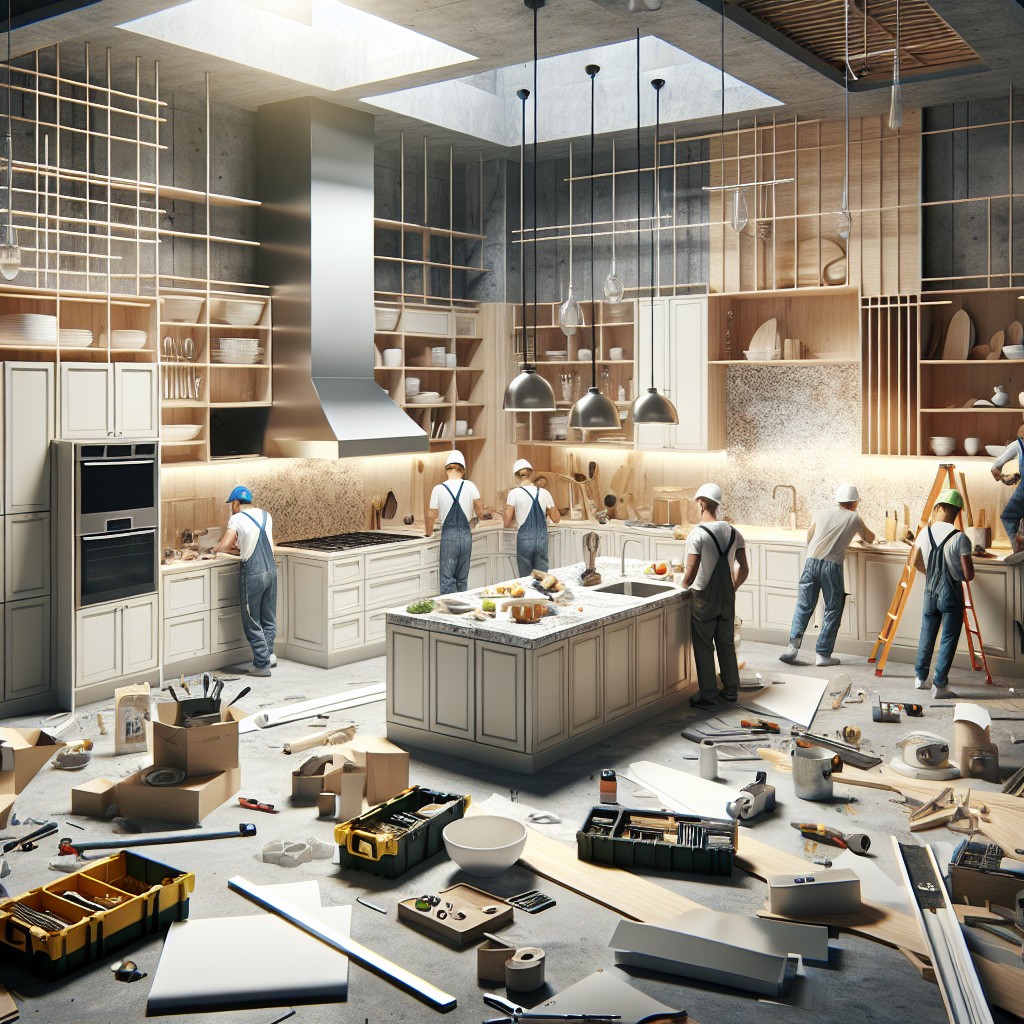Last updated on
Harness the potential of your cooking space with this practical guide on kitchen remodels, offering you useful tips and insights to make your dream kitchen a reality.
Key takeaways:
- Pinpoint scope of remodel: walls, cabinets, appliances, dining area.
- Set budget: allocate funds, categorize expenses, consider sales.
- Choose design theme: harmony, color scheme, materials, storage, accents.
- Consider hiring professionals or DIY: assess skills, time, and budget.
- Integrate smart home technology: appliances, lighting, sensors.
What's Inside
Defining the Scope of the Remodel

Embarking on a kitchen remodel is thrilling yet requires a decisive approach to scope. This means pinpointing precisely what you aim to change. Will you be knocking down walls for an open-concept kitchen, or maybe updating the cabinets and countertops is the extent of your plan?
Consider appliance upgrades – are these necessary for enhanced functionality or energy efficiency? Be sure to evaluate your storage needs to ensure ample space for all your gadgets and grocery items. Also, factor in whether you need a space for dining or a multifunctional area that could accommodate a quick breakfast nook.
It’s vital to nail down these details early on as they dictate the project’s direction, timeline, and ultimately, its success.
Setting a Budget
Determining your financial boundaries is paramount to a successful kitchen remodel. Allocate funds for core aspects such as cabinetry, appliances, and labor while reserving a portion of your budget for unexpected costs; an often-overlooked consideration that can make or break the remodeling experience.
To add precision to your planning, itemize expenses, categorizing by must-haves and nice-to-haves. This detailed approach not only provides a financial roadmap but also allows you to adjust allocations as quotes and prices materialize.
Always keep an eye out for potential sales or discounts on high-ticket items and consider phases of construction where you might be able to economize without sacrificing quality. Remember, striking a balance between your dream kitchen features and the practicality of your budget is key to a result you’ll love without financial stress.
Choosing a Design Theme
When it comes to crystallizing your vision for aesthetics, it all boils down to personal preference and lifestyle needs. Here’s a quick dive into some considerations:
Harmony and Cohesion: Your kitchen shouldn’t clash with the rest of your home. If your house exudes a modern, minimalist vibe, a rustic country kitchen might feel out of place. Aim for a flow that gently ties spaces together.
Color Scheme: A guided palette can set the mood. Soft neutrals can create a calming environment, while bold colors can inject vibrancy and energy. Look to color theory for cues on which hues complement each other.
Material Selection: Durability meets design in the choices of granite, quartz, hardwood, and more. Each offers not just a specific look but also practical benefits. For example, butcher block counters are ideal for avid chefs, while engineered surfaces offer low maintenance for busy homes.
Storage Solutions: Visually pleasing organization options such as open shelving can showcase beautiful dishware, while paneled appliances provide a sleek, uninterrupted appearance. Think about how you use the space to determine the right balance of form and function.
Accent Pieces: Lighting fixtures, cabinet hardware, and backsplash tiles are the jewelry of the kitchen. These elements offer a chance to be bold and express creativity without overwhelming the design.
Scrutinizing these aspects with an eye for detail ensures your new kitchen will not just look good but feel right, too. After all, this heart of the home is where both meals and memories are made.
Hiring Professionals or DIY
When considering whether to enlist professionals or embark on a DIY journey, assess your skill level alongside time and budget constraints. Professionals bring expertise and efficiency but at a higher cost. Tapping into the DIY spirit can lead to significant savings and offers a personal sense of accomplishment, but it’s not without risks.
- Experts can tackle complex tasks like electrical and plumbing work, ensuring safety and compliance with local building codes.
- A professional designer can help maximize kitchen functionality and aesthetic appeal.
- Hiring out can speed up the process, minimizing the time your kitchen is out of commission.
- DIY projects allow you to learn new skills and customize the space to your exact preferences.
- Consider mixing both approaches: DIY for simpler tasks like painting and professionals for structural work.
- Remember to factor in the value of your own time when contemplating DIY; sometimes, time is more precious than money.
Smart Home Technology Integration
In the digital age, kitchens have transformed into highly connected spaces. Smart home technology not only boosts convenience but also enhances efficiency, potentially reducing energy costs.
Consider integrating appliances that can be controlled via smartphone or voice commands. For example, smart refrigerators can keep track of groceries and expiry dates, while a smart oven can preheat remotely, getting dinner prep started before you even get home.
Don’t overlook smaller additions, like smart lighting that can adjust the ambiance of your kitchen at the touch of a button or a voice command. Programmable coffee makers can ensure your morning brew is ready when you wake up, and a smart dishwasher can be scheduled to run during off-peak energy hours.
Additionally, smart sensors, such as leak detectors under the sink, provide peace of mind by warning you of potential issues before they escalate into costly disasters.
The key is to select technology that meshes with your lifestyle, ensuring a seamless blend of functionality and design. Remember to ensure your Wi-Fi network is up to the task, as the best smart kitchen is only as good as its connection.




